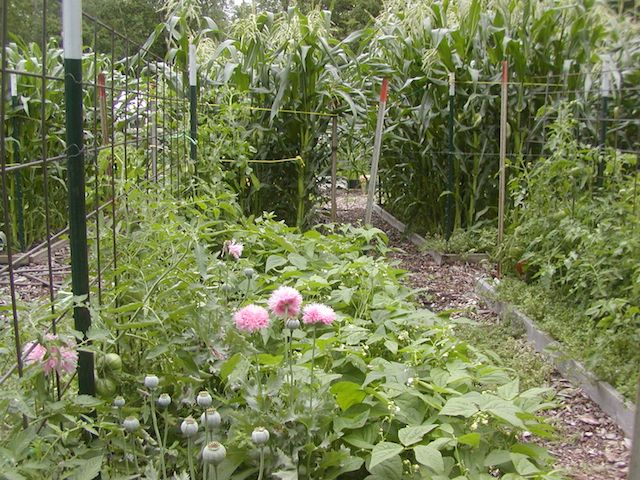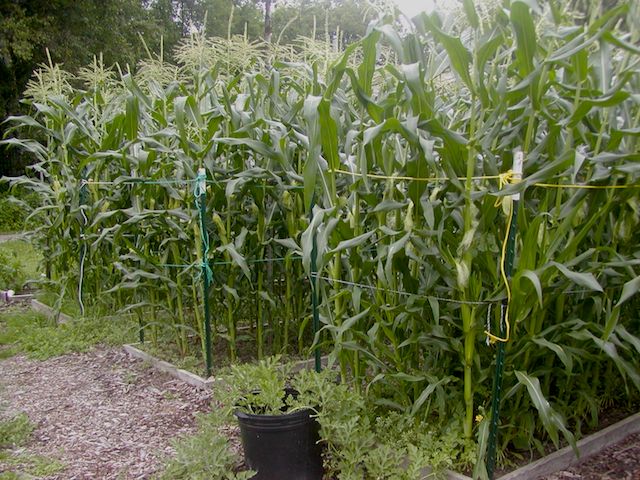

|
General discussion regarding the techniques and methods used to successfully grow tomato plants in containers.
|
 |
|
|
Thread Tools | Display Modes |
|
|
#16 |
|
Tomatovillian™
Join Date: May 2006
Location: Rock Hill, SC
Posts: 5,346
|
Stowell's is an older sweet corn variety (I personally grow Ambrosia) but it grows tightly wrapped husks and rarely gets worms.
http://www.slowfoodri.org/2009/04/01...ls-sweet-corn/ I've found it helps to remember that corn is really an incredibly tall cultivated grass.
__________________
[SIZE="3"]I've relaunched my gardening website -- [B]TheUnconventionalTomato.com[/B][/SIZE] * [I][SIZE="1"]*I'm not allowed to post weblinks so you'll have to copy-paste it manually.[/SIZE][/I] |
|
|

|
|
|
#17 | |
|
Tomatovillian™
Join Date: Feb 2006
Location: Den of Drunken Fools
Posts: 38,539
|
Quote:
This you dont have to worry about nor do you have to walk between the rows as was stated before. In all honesty I would go with more of a square foot approach to it in the raised bed with more or less 2 plants per square foot. By doing this I would space the plants 6 inches apart in rows 12 inches apart. This will give you 60 plants in a 4X8 bed with the plants 6 inches from the edge and ends. Depending on what variety of corn you grow will determine how many ears you get per plant. At the least it will be 60 ears and on average it would be 120 ears. The other ting you can do they dont have the option to do in a big field is to shake the stalks when they are potting out pollen. Also if you haven't looked at the other video play close attention to how deep to plant the seeds. I have seen them planted to shallow before and the plants fall over. Feldon stated about the fertilizer. Corn is a grass and it needs to be treated as such with a high nitrogen fertilizer and lots of it. Bagging the ears is also a good idea after they have pollinated. Each silk on an ear of corn goes to an individual grain inside the corn. This is why you sometimes see a dead spot or row on a ear of corn. Those silks didn't pollinate. Last but not least here is a pictuer of you raised bed with the corn layout in it. Worth Corn spacingr.jpg |
|
|
|

|
|
|
#18 | |
|
Tomatovillian™
Join Date: Jan 2006
Location: Northern Minnesota - zone 3
Posts: 3,231
|
Quote:
 The other problem from lack of enough light is your cornstalks are weaker and more apt to keel over if you have heavy wind and rain, which makes an ugly mess in raised beds. We get a lot of wind, so I have learned to put a steel post at the corner of each bed, and run a rope around each bed as the corn plants get high enough to be bothered. They still will be tipped in wet ground, but at least they won't go down, and the aisles between are kept clear. 
__________________
Dee ************** Last edited by ddsack; February 28, 2016 at 03:18 PM. |
|
|
|

|
|
|
#19 | ||
|
Tomatovillian™
Join Date: Mar 2015
Location: Zone 5A, Poconos
Posts: 959
|
Quote:
Quote:
|
||
|
|

|
|
|
#20 |
|
Tomatovillian™
Join Date: Feb 2006
Location: Den of Drunken Fools
Posts: 38,539
|
One thing we must consider is what zone we live in when growing corn or anything else.
You can get away with a lot more due to the strength and angle of the sun down here. |
|
|

|
|
|
#21 | |
|
Tomatovillian™
Join Date: Mar 2015
Location: Zone 5A, Poconos
Posts: 959
|
Quote:
It would probably also help more to plant the back row(s) earlier so that it matures slightly faster (assuming the rows are is east-west). But then again I did go 5' wide with my bed, instead of 4', to give the additional space and do not need to bother to reach toward the center because it is empty. Last edited by rhines81; February 28, 2016 at 09:55 PM. |
|
|
|

|
|
|
#22 | |
|
Tomatovillian™
Join Date: Feb 2006
Location: Den of Drunken Fools
Posts: 38,539
|
Quote:
I am going to leave one foot right down the middle with a board there to walk on. Now this thread has got me wanting to plant corn some place.  But not the beds they are for Okra. Worth. |
|
|
|

|
|
|
#23 |
|
Tomatovillian™
Join Date: Mar 2015
Location: Zone 5A, Poconos
Posts: 959
|
|
|
|

|
|
|
#24 |
|
Tomatovillian™
Join Date: May 2013
Location: Cache Valley, N/E of The Great Salt Lake
Posts: 1,244
|
I believe that to be the best guidance that I have read on this thread.
|
|
|

|
|
|
#25 |
|
Tomatovillian™
Join Date: Jun 2015
Location: Colorado
Posts: 134
|
I normally space my corn 1' or 12" apart. But i grow in organic conditions i guess you'd say with less than ideal soil. I really would never plant corn any closer than that and honestly i suspect my corn is too close at that spacing. Never tried 2' spacing, but i really think my corn would do better under those conditions. But everyone's soil and conditions are different. Do what you feel is best.
In a raised bed i would also second the advice to plant three rows with the outer rows 6" from the edge and the middle row 12" from either side row. |
|
|

|
|
|
#26 |
|
Tomatovillian™
Join Date: Jan 2013
Location: Colorado
Posts: 124
|
I agree with ddsack on the spacing. For those with dryer climates that have to water, once the plants are up don't over water. Let it go till the plants start to turn blue, this will make the roots go deeper and the plant less likely to fall over. The most critical time for water is when you see the first tassel starting to poke out. Another suggestion is to remove any suckers that form at the base of the plant they serve no real purpose.
Good luck Marcus |
|
|

|
|
|
#27 |
|
Tomatovillian™
Join Date: Jul 2014
Location: fortville,IN 46040
Posts: 140
|
The suckers supply the plant with moisture in a drought. When plenty of rain you may get bonus ears. Back when, farm fields were full of suckers, now none around
|
|
|

|
|
|
#28 |
|
Tomatovillian™
Join Date: Mar 2016
Location: Toronto
Posts: 1
|
I too had an almost same doubt while thinking about having a raised bed. According to the experts from “In the backyard, raised garden bed experts” in Canada (I got their help), It’s good for corns to plant them in blocks as it helps for pollination purposes and should be planted about 12 inches apart. For dwarf varieties like Early Alaska in a fertile organic soil, you could make a crop at 4 plants per square foot. For other crops, such as bush beans and other low-growing vegetables, a minimum standard distance is needed so as not to crowd each other out and deplete the soil too quickly of the nutrients they all need.
|
|
|

|
 |
|
|
